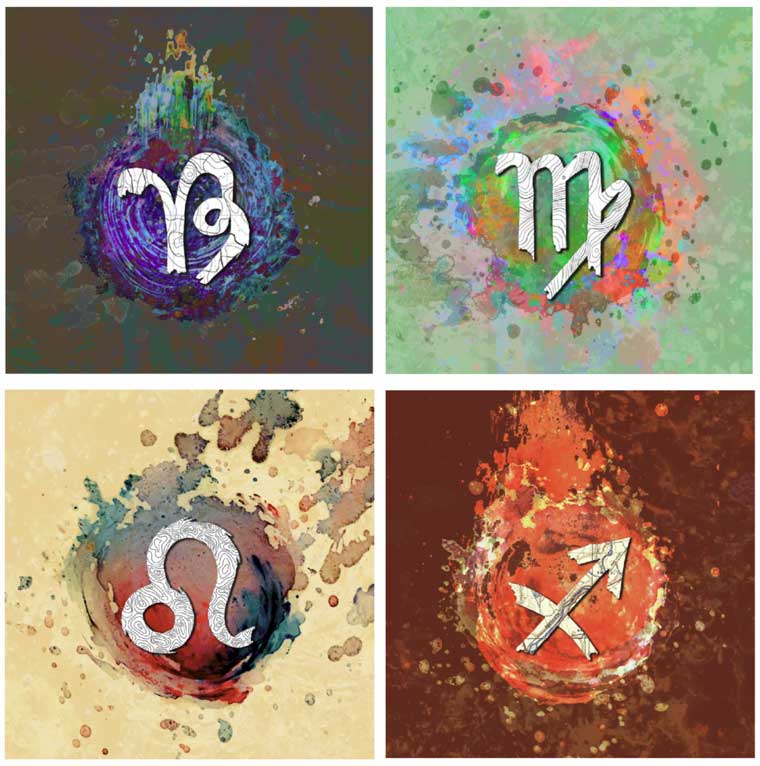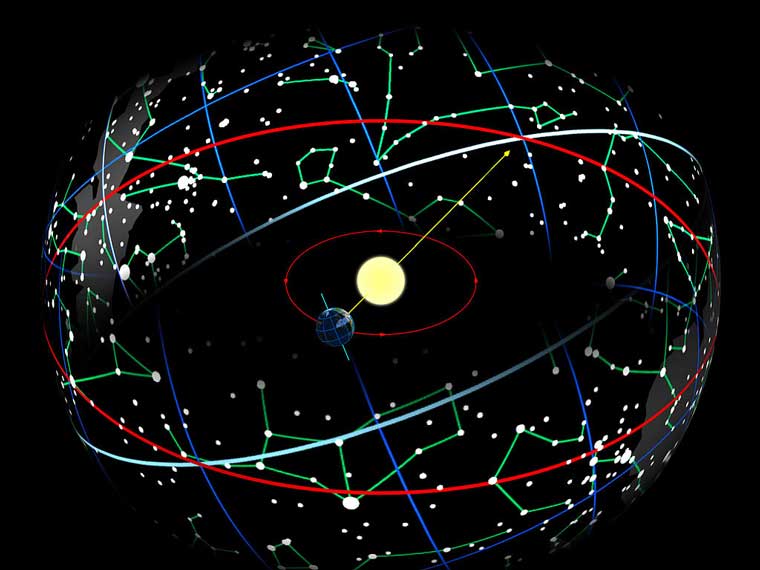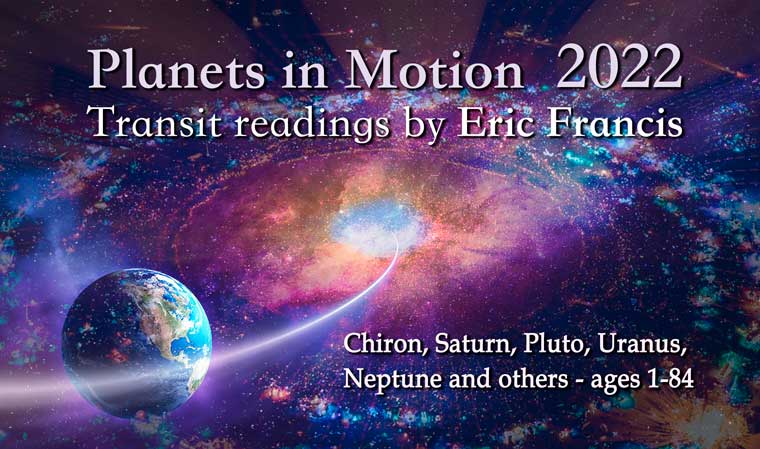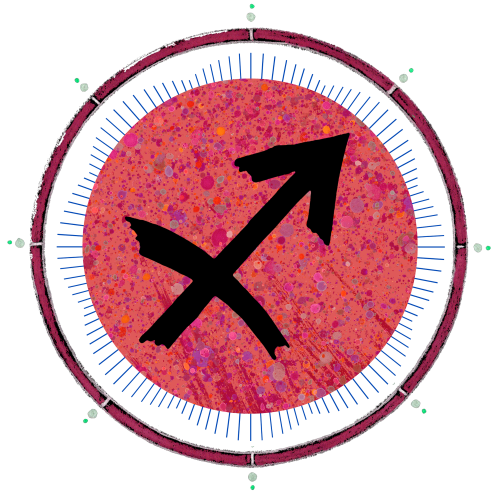You might say that transits describe the ongoing discovery of who you are as told by your astrology. If you follow astrology closely enough to know about this, they reveal to you how your chart works when natal planets and points are activated.

An Introduction to Transits: Realtime Planets in Motion Collaborating with Natal Planets (sample transits here)
Dear Friend and Reader:
“THE TRANSITS COME,” said Sue Wilens, one of the first astrologers to read my chart.
Transits are planets in motion that make aspects to planets in your natal chart. They represent moments of evolution, development, growth and discovery. They can also represent times of crisis. As such, they present opportunities. A good astrologer helps you make the translation from an astrological event to realizing its potential. You can learn how to do some of this for yourself.

When most people new to astrology consider the ‘meaning’ of their chart, it’s about looking at their natal placements (meaning their birth chart) by house and sign, and the relationships planets make to one another (called aspects). Planets are considered as fixed points, when really, they are moving all the time.
Transits animate the birth chart, and show you what is going on in your chart now. Instead of representing natal placements you live with all the time, they represent developments and events that come and go over the course of time.
You might say that transits describe the ongoing discovery of who you are as told by your astrology, and if you follow astrology closely enough to know about this, they reveal to you how your chart works when natal planets and points are activated.
They change constantly, and exist in a dynamic: as energy factors mutually influencing one another. That makes all transits original experiences, because every chart has a unique pattern in space, time and expression.
If astrology has any meaning at all, it comes from context. A chart is irrelevant without the reality that it describes, which is found many places: whose chart is involved, the age the transit is happening, the events in the personal life and society around the person, and numerous other factors that you will never see written about in an astrology book or website. Remember: without context, there is no meaning.
Depending on your age, you have had many or most of the transits I describe in this e-book. While some are one-time events for certain age groups, others happen to everyone at that age. I will draw this distinction in each of the entries. From the ones on this list, at least the ones that apply to your cohort and/or year of birth.
The attitude (angle, posture, viewpoint) with which you approach a transit makes all the difference in how it manifests — all of it. Your point of view is a vital part of the context. All astrology is made up, and part of how you make it up is what you decide something means and how you interpret the basic astrological facts you’re presented with. It helps to take a creative orientation.
It’s also helpful to know your transit history, meaning the history of your prior transit events. After studying the transits of thousands of clients, I can tell you that this is one of the most effective astrology tools I know of, and few astrologers do it. This is yet another matter of context. Any Saturn transit, for example, is in the context of all the others you’ve had.
Depending on your age, you have had many or most of the transits I describe in this e-book. While some are one-time events for certain age groups, others happen to everyone at that age. I will draw this distinction in each of the entries. From the ones on this list, at least the ones that apply to your cohort and/or year of birth. If you are interested in going into detail, I can do an accounting of the salient ones for you as part of a consultation or as a modestly priced stand-alone service. Then you would journal the times given and get a sense of how your natal chart responds when the energy is turned up.
Your transit diary entries, in which you describe specific time phases of your life, may turn into one of your most useful personal growth and self-therapy tools.
Perhaps the easiest way to understand transits is to observe how the positions indicated in the natal chart represent the positions of planets as if they have stopped, which are shown in time at various points along their orbital cycles. When those cycles reach specific stages (such as the 90-degree mark, opposition or return), or when they cross and overlap one another, there is a result in your life.

Your Chart is an Astral Image of the Past
How transits work is a little strange, if you think about it. Your natal chart is a picture of a planetary formation in the past. It does not really exist now, except as a phantom, or an astral entity. Yes, it’s associated with you, though in what form?
Yet when the transits arrive, which means, when planets in realtime are forming angles to a natal planetary pattern that no longer exists (except in your chart), you get a response — and the response often fits the energies of the transit perfectly. As you notice this happening, it seems obvious that it works. Yet it’s best not to explain this away, such as by pretending you know how it works, or making up theories you take too seriously. Keep an open mind. For now, just appreciate that it somehow does, and let the method be a mystery that you honor as part of the great unknown.
Perhaps the easiest way to understand transits is to observe how the positions indicated in the natal chart represent the positions of planets as if they have stopped, which are shown in time at various points along their orbital cycles. When those cycles reach specific stages (such as the 90-degree mark, opposition or return), or when they cross and overlap one another, there is a result in your life.
Yet this still does not solve the mystery of how they work, meaning, why there are events in life that correspond with times when planetary cycles reach certain points. Many would say it’s not happening — that it’s only observer bias. However, if you study transits for a while, it becomes difficult to reasonably deny: you would have to ignore much practical evidence.
Outer planets (which I am counting as Saturn through Eris) move slowly, and millions of people are born with them in a position or pattern. As a result, a discussion like this is possible, which is highly specific for the people born in the time range of the transit.

Personal and Collective Transits
There are two main kinds of transits. One is the type that affects large cohorts and sub-generations, which I am covering in this e-book. These happen at the same age for everyone, such as the Saturn return at age 29. Then there are the kinds that affect specific individuals, such as a planet moving over the ascendant, Moon, Sun or personal planet, which are not covered. Personal events are important, though they are more easily covered in a reading, and what they ‘mean’ is always a matter of interpretation and context. Yes, it’s all a made-up story, framed in the reality of your life.
There is a third class, which you might say is halfway between individual and collective, pertaining to specific years of birth. As this project has developed, I have included more of those in my accounting of transits. A nearly infinite number of them exist; the readings below will give you a taste of the possibilities and cover a good few events. You can take these ideas and convey them into other transits, as appropriate.
Outer planets (which I am counting as Saturn through Eris) move slowly, and millions of people are born with them in a position or pattern. As a result, a discussion like this is possible, which is highly specific for the people born in the time range of the transit.
This discussion will serve as a basic guide to the transits described in other eras of time. In other words, you will see what transits are possible, and as I mentioned a moment ago, you may study your own transit history. If you want to understand your astrology, in my opinion, you must study your past transits, which takes you beyond considering what the static particles in your natal chart mean. Transits are a form of context that grant meaning.
The discussion in this e-book does two things that even the best books about transits cannot do. One is that it addresses aspect patterns. For example, you might read about the Chiron opposition in a Chiron book, but you will be unlikely to read about the Chiron opposition happening in the charts of people born with their natal Chiron opposite their natal Uranus. I cover those types of patterns in as much detail as possible.
In addition, I can take sign placements into account; I have that information because I’m working with the year or era of your birth. Most transit books do not do this; they do not take sign placements into account, discussing only aspects.
The sign placement and aspects to other planets help refine an interpretation and provide helpful context. The houses bring this into much greater detail. Once you figure out what house or houses an event involves in your chart (or one you are reading for another person), you can put the event in its place. This is easier than it seems. Place is another word for house, and houses all designate physical places in your life.

Sign Placements Give Context; Houses Offer More Context
The houses are very important in astrology. Houses are based on the time of birth. They tell us where and how events are more likely to manifest. They provide context. It is possible to get a lot done without them — there are ways to do that well, which I use in my astrology studio readings, for example. Because I am not working with your birth time, I don’t know the houses that these transits involve. But you can find out, and add this to your thought process when you investigate your transits.
The sign placement and aspects to other planets help refine an interpretation and provide helpful context. The houses bring this into much greater detail. Once you figure out what house or houses an event involves in your chart (or one you are reading for another person), you can put the event in its place. This is easier than it seems. Place is another word for house, and houses all designate physical places in your life.
You may use the solar house method I use in my Astrology Studio and annual readings, counting houses from the Sun. If these interpretations get the attention of your curiosity, I suggest you listen to the class It’s All in the Houses and/or read some of what I have written on this topic.
One note on language: the transits are expressed in professional astrological notation. The first planet referenced is the transiting planet moving in realtime. The second is the planet being transited. Hence, “Pluto conjunct Saturn” means transiting Pluto conjunct natal Saturn. “Neptune square Neptune” is transiting Neptune square natal Neptune.
There is much more to say about these transits than I am writing here. However, plenty of that “more” comes from you and your personal experience now, and during related transits you’ve had in the past. The real context of your chart is your life. Yet your life also has a wider context, which is the world in which you live.
The idea of astrology is to see yourself in an expanded frame of reference, and this works many ways. With astrology, we are looking at the apparent (or subtle) messages and influences of distant planets, stars and galaxies as part of that frame. Yet astrology is about what happens on Earth. It is about how we relate to the world in which we live our lives.

Historical Events Around Your Birth Era Matter
In some of the discussions below, I provide historical context when I am discussing events at the time of your birth. I consider this a valuable and fun element of astrology — in truth, an essential element of many readings (particularly of natal charts). Studying astrology has led me into a passion for investigating and studying history, where individuals fit into history, and the place where natal charts and the charts of historical events overlap.
The idea of astrology is to see yourself in an expanded frame of reference, and this works many ways. With astrology, we are looking at the apparent (or subtle) messages and influences of distant planets, stars and galaxies as part of that frame. Yet astrology is about what happens on Earth. It is about how we relate to the world in which we live our lives.
Events when and where you were born say something about you. You might think you were born in the wrong time and place, or the right one — that is an important consideration. Regardless, you were born when you were born and have astrology similar to planetary events of that time, and other people born then.
As one born during the aspect that describes historical events, you also embody the astrology that signified them. Older people who lived through the era experienced the same astrology as a transit, which means as a passing phase. In whatever era you were born, you embody the qualities of that time as a direct, lifelong potential.
Since the 1920s there has been much astrology that represents rapid alterations in the course of the world as we know it, which have paralleled rapid technological advances. All of this influences the trajectory of your life and the meaning of your chart.
The study of personal astrology is in many ways the study of transits. They will teach you more about your natal chart than any book could possibly offer. This is because your natal placements are unique and not covered in any book, and then your natal placements find unique expression at the time of transits.

A Study of the Total Astrological Life Cycle
While the transits in this e-book are oriented in the present time, many of them happen to everyone. I suggest you take the whole sequence of transits as a description of a whole process; a full cycle — several, perhaps, since Saturn goes around once every 29 years.
If you read the whole e-book, you will have an overview of many of the major transits that you will experience: all of the ones that are defined by generation and year of birth, which are collective transits, and a sample of what unique personal transits might be about, though yours will differ.
Please take the time to learn more about these, and also to learn your personal transits (for example, outer planets making aspects to your Sun, Moon, rising sign or other important placements).
The study of personal astrology is in many ways the study of transits. They will teach you more about your natal chart than any book could possibly offer. This is because your natal placements are unique and not covered in any book, and then your natal placements find unique expression at the time of transits.
Your chart is the actual book — the book of your life — and it emerges in real-life as your transits happen. Astrology is discovered in layers, through experience, and through slow, careful reflection. It never gives easy answers, which is a good thing: you don’t want any. They don’t really exist.
With love,

Get the Book and the Audio




